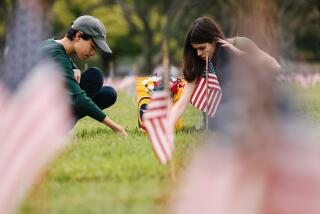Sprucing up Palmdaleâs historic grave sites
Glen Settle, 97, knew he had to act fast.
The concrete marker on the grave of his sister Aileen, who died in 1918 at just 3 days old, was worn and faded. It needed to be replaced.
So earlier this month, a friend helped Settle erect a new gray granite stone engraved with a baby angel at the plot in the Historic Palmdale Cemetery.
Settle is among a group of descendants of the cityâs early settlers buried in the cemetery who are rushing to repair or replace grave markers, monuments and headstones before a July 16 deadline, when the city will take over general maintenance of the property that will be rededicated as Pioneer Memorial Park.
The cemetery will be closed to future renovations and burials, unless people can prove they owned plots before the cityâs 2006 resolution to close the grounds to interment. The cemetery includes at least 200 graves, and they will be maintained as they are now.
âItâs nice to know that it will be taken care of now,â said Settle, whose family arrived in Palmdale in 1908. âI think it means a lot to the old-timers.â
The cemetery is one of the few reminders of the early Palmdale settlement known as âPalmenthal,â said city spokesman John Mlynar. About 60 families of Swiss and German descent traveled mainly from Nebraska and Illinois and settled in the area in 1886.
They founded a Lutheran church. One family donated 20 acres to the church, which includes about 2 1/2 acres at the northeast corner of 20th Street East and Avenue S that are known to have graves. By 1899, most of the pioneers had moved away from Palmenthal because of drought, land deed issues and competition from a neighboring community called Harold, in an area now known as central Palmdale. The newcomers settled closer to the Southern Pacific Railroad tracks, Mlynar said.
The cemetery continued to be used by other settlers, but it eventually fell into disrepair, a victim of overgrown vegetation, graffiti, trash and vandalism. The last burial on record was in 2001, but that remains in dispute because the former property owner officially closed the cemetery to burials in 1999.
In 2006, the city committed about $220,000 to clean up the cemetery, with $30,000 more allocated for annual maintenance of the site. Ground-penetrating radar equipment was used to check for additional unmarked graves, Mlynar said. In 2008, a wrought iron fence was erected around the cemetery to guard against further destruction.
âThe city and the community respect this place as the final resting place of the pioneers of the city,â said Noel Doran, Palmdaleâs deputy city attorney, who has helped steer the municipality through the legal process of creating a pioneer park. âItâs an opportunity for our generation and future generations to connect to the past.â
Genealogists and historians praised Palmdaleâs efforts to create a pioneer memorial park at a time when some cities and counties are allowing historic cemeteries to languish.
Sue Silver, state coordinator for California Saving Graves, a group dedicated to preserving and restoring endangered and forgotten cemeteries, said human âapathy and moral decayâ had contributed to the demise of some of these historic sites.
âTo me itâs not a matter of economics, itâs a matter of being ready and willing to commit the time and the effort,â Silver said, noting that Palmdale âdeserves a lot of credit.â
Some jurisdictions have been slammed for allowing historic cemeteries to be turned into play parks and soccer fields. In the early 1970s, outrage erupted over a decision to convert a portion of San Diegoâs Calvary Cemetery into a public park. And today, some Ventura residents are fighting to get the cityâs Cemetery Memorial Park restored to its original state. In the mid-1960s, the grave markers of more than 3,000 of the cityâs most influential pioneers were unceremoniously removed, and the cemetery was transformed into a city park.
At the Palmdale cemetery, grave markers bear names of pioneer families, including Jonas, Nagel, Ritter and Munz. Descendants recalled that they created a town with stores, a blacksmith shop, a bakery and a shoe shop.
Barry Munz, 48, whose great-grandparents are among those buried in the historic graveyard, said his descendants were grain and livestock farmers. Historical records show that one of the Munzesâ started a pioneer turkey ranch in Antelope Valley and developed the Holland strain of white turkey.
Ralph Ritter, 80, recalled that pioneer members of his family owned an abundance of land, flourishing orchards and a winery. His grandfather had immigrated to the U.S. from Germany and later moved to California.
Other early families included the Settles, Kimbroughs and Coursons.
Plots lie in clusters across the rugged desert floor, spotted with California junipers, Italian cypress and at least one Joshua tree. A horseshoe-shaped path made of decomposed granite allows passage around the graves.
Relatives of the deceased have been encouraged to place grave markers, monuments, headstones and other embellishments in accordance with the cemeteryâs simple, non-gaudy style. Walkways, statues and gargoyles are not allowed for individual graves.
Marge Kimbrough, 81, whose deceased husband is among 11 Kimbrough family members buried in a cordoned-off lot at the cemetery, said she was thrilled that the graveyard was being preserved.
âWe are such a transient state, itâs important to keep some of the old legends from the past,â Kimbrough said. âI think we all like to feel our roots.â
Munz said that given the cemeteryâs age and prior deteriorating state, âsomething needed to be done. The city stepping in was by far the best for the overall community.â
--
More to Read
Sign up for Essential California
The most important California stories and recommendations in your inbox every morning.
You may occasionally receive promotional content from the Los Angeles Times.











